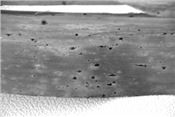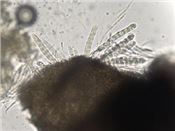Corn Disease Alert: New Fungal Leaf Disease “Tar Spot” Identified In 3 Northern Illinois Counties
DR. SUZANNE BISSONNETTE
URBANA, ILL.
Tar spot confirmed: Announced by the Illinois Department of Agriculture today. Corn leaf samples from 3 northern Illinois counties have been confirmed positive for the fungus Phyllachora maydis by Megan Romby National Plant Pathologist with the USDA Animal Plant Health Inspection Service in Beltsville, MD. Positive counties in Illinois are LaSalle, DeKalb and Bureau. The samples were collected from commercial fields by Monsanto breeders and pathologists and sent to Dr. Kiersten Wise in response to her inquiry for samples and distribution information of the Tar spot pathogen. Dr. Wise and Purdue Plant Clinic director Gail Ruhl initially identified the pathogen which is new to the United States 1 ½ weeks ago and submitted confirmation samples to the USDA http://extension.entm.purdue.edu/pestcrop/2015/Issue24/ . Upon receipt of the Illinois samples, they diagnosed the fungus, contacted us at the University of Illinois Plant Clinic and submitted the Illinois samples to the USDA for confirmation at our request.
Scouting for the disease has been active in Illinois. Jennifer Chaky , Pioneer Plant Diagnostic Clinic, also has samples from Bureau County diagnosed with Tar spot and we have additional LaSalle county samples from our University of Illinois Extension Agronomist in Northern IL, Russ Higgins.
Tar spot has distinctive symptoms. The fungal fruiting body, called an ascomata, really does look like a spot of tar on the leaf. Lesions are black, sunken oval to circular. They can be small flecks of about 1/64” up to about 5/64”. The lesions can merge together to produce an affected area up to 3/8”. If you run your finger across the leaf you will feel tiny bumps.
Prior to the Indiana finding, Tar spot was known to occur only in cool humid areas at high elevations in Latin America. There are actually 2 fungi that cause Tar spot disease on corn Phyllachora maydis and Monographella maydis. While Monographella maydis is known to be able to cause economic yield losses in Latin America, Phyllachora maydis is not known to significantly reduce yield. Other pathogens may be confused with Tar spot, especially the overwintering teliospore (black) phase of corn rust. Also, there are many fungi, called saprophytes that feed on dead corn tissue and form black splotches on the leaves.
To date only one of the pathogens, Phyllachora maydis, has been found in IN and IL. If you suspect Tar spot please submit a sample to the University of Illinois Plant Clinic. We would like to get a comprehensive idea of distribution in the state. For more information on tar spot of corn, please see the USDA-ARS Diagnostic Fact Sheet: http://nt.ars-grin.gov/taxadescriptions/factsheets/index.cfm?thisapp=Phyllachoramaydis . ∆
DR. SUZANNE BISSONNETTE: Plant Diagnostic Clinic and IPM coordinator, University of Illinois

Figure 1. Black ascomata of Tar spot on corn leaves in LaSalle County, IL. Note that
orange rust pustules are also present on this leaf.
Photo courtesy of Russ Higgins University of Illinois Extension

Figure 2. Microscopic view of fruiting structure of Tar spot from Bureau County, IL.
Photo courtesy of DuPont Pioneer Diagnostician, Jennifer Chaky